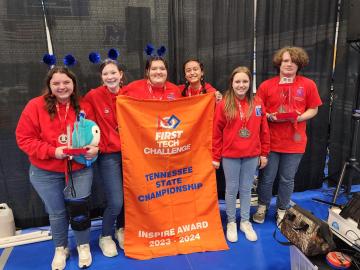Filter News
Area of Research
- Advanced Manufacturing (5)
- Biological Systems (1)
- Biology and Environment (102)
- Biology and Soft Matter (4)
- Building Technologies (2)
- Chemical and Engineering Materials (3)
- Chemistry and Physics at Interfaces (7)
- Clean Energy (168)
- Climate and Environmental Systems (7)
- Computational Biology (1)
- Computational Chemistry (5)
- Computational Engineering (1)
- Computer Science (3)
- Data (1)
- Earth Sciences (1)
- Electricity and Smart Grid (1)
- Energy Frontier Research Centers (7)
- Fuel Cycle Science and Technology (2)
- Functional Materials for Energy (8)
- Fusion and Fission (32)
- Fusion Energy (7)
- Geographic Information Science and Technology (1)
- Isotopes (21)
- Materials (122)
- Materials for Computing (13)
- Materials Synthesis from Atoms to Systems (8)
- Materials Under Extremes (7)
- National Security (44)
- Neutron Data Analysis and Visualization (2)
- Neutron Science (72)
- Nuclear Science and Technology (27)
- Quantum Condensed Matter (3)
- Quantum information Science (4)
- Renewable Energy (2)
- Sensors and Controls (2)
- Supercomputing (153)
- Transportation Systems (4)
News Type
News Topics
- 3-D Printing/Advanced Manufacturing (33)
- Advanced Reactors (6)
- Artificial Intelligence (38)
- Big Data (21)
- Bioenergy (46)
- Biology (53)
- Biomedical (26)
- Biotechnology (9)
- Buildings (16)
- Chemical Sciences (19)
- Clean Water (14)
- Climate Change (44)
- Composites (5)
- Computer Science (76)
- Coronavirus (17)
- Critical Materials (1)
- Cybersecurity (14)
- Decarbonization (39)
- Emergency (2)
- Energy Storage (28)
- Environment (98)
- Exascale Computing (21)
- Fossil Energy (3)
- Frontier (19)
- Fusion (27)
- Grid (21)
- High-Performance Computing (38)
- Hydropower (5)
- Isotopes (23)
- ITER (2)
- Machine Learning (19)
- Materials (37)
- Materials Science (37)
- Mathematics (5)
- Mercury (7)
- Microelectronics (2)
- Microscopy (19)
- Molten Salt (1)
- Nanotechnology (16)
- National Security (30)
- Net Zero (6)
- Neutron Science (43)
- Nuclear Energy (49)
- Partnerships (11)
- Physics (25)
- Polymers (7)
- Quantum Computing (15)
- Quantum Science (24)
- Renewable Energy (1)
- Security (10)
- Simulation (25)
- Software (1)
- Space Exploration (11)
- Summit (29)
- Sustainable Energy (37)
- Transformational Challenge Reactor (3)
- Transportation (25)
Media Contacts
OLCF and APPL have collaborated on an automated data pipeline to manage data from APPL's hyperspectral imaging tools. The collaboration is an early effort of DOE's Integrated Research Infrastructure.

ORNL scientists have spent the past 20 years studying quantum photonic entanglement. Their partnership with colleagues at Los Alamos National Laboratory and private industry partner Qubitekk led to development of the nation’s first industry-led commercial quantum network. This type of network could ultimately help secure the nation’s power grid and other infrastructure from cyberattacks.

In the age of easy access to generative AI software, user can take steps to stay safe. Suhas Sreehari, an applied mathematician, identifies misconceptions of generative AI that could lead to unintentionally bad outcomes for a user.

Nuclear nonproliferation scientists at ORNL have published the Compendium of Uranium Raman and Infrared Experimental Spectra, a public database and analysis of structure-spectral relationships for uranium minerals. This first-of-its-kind dataset and corresponding analysis fill a key gap in the existing body of knowledge for mineralogists and actinide scientists.

Scientists at ORNL have developed 3D-printed collimator techniques that can be used to custom design collimators that better filter out noise during different types of neutron scattering experiments
ORNL scientists have determined how to avoid costly and potentially irreparable damage to large metallic parts fabricated through additive manufacturing, also known as 3D printing, that is caused by residual stress in the material.

Alyson Coates, a Senior Technical Staff Member in ORNL's Fusion and Fission Energy and Science Directorate, noticed a need for more STEM programs for young girls in her rural community in Blount County. So, she decided to fill the gap herself.

SkyNano, an Innovation Crossroads alumnus, held a ribbon-cutting for their new facility. SkyNano exemplifies using DOE resources to build a successful clean energy company, making valuable carbon nanotubes from waste CO2.

College intern Noah Miller is on his 3rd consecutive internship at ORNL, currently working on developing an automated pellet inspection system for Oak Ridge National Laboratory’s Plutonium-238 Supply Program. Along with his success at ORNL, Miller is also focusing on becoming a mentor for kids, giving back to the place where he discovered his passion and developed his skills.

Astrophysicists at the State University of New York, Stony Brook and University of California, Berkeley, used the Oak Ridge Leadership Computing Facility’s Summit supercomputer to compare models of X-ray bursts in 2D and 3D.




